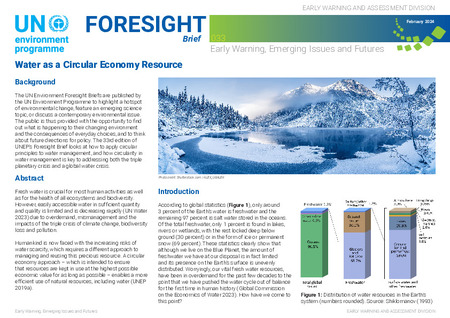| dc.contributor | Early Warning and Assessment Division | en_US |
| dc.contributor.author | United Nations Environment Programme | en_US |
| dc.date.accessioned | 2024-02-08T06:59:12Z | |
| dc.date.available | 2024-02-08T06:59:12Z | |
| dc.date.issued | 2024-02 | |
| dc.identifier.isbn | 978-92-807-4123-0 | en_US |
| dc.identifier.other | DEW/2613/NA | en_US |
| dc.identifier.uri | https://wedocs.unep.org/20.500.11822/44782 | |
| dc.description | Fresh water is crucial for most human activities as well as for the health of all ecosystems and biodiversity. However, easily accessible water in sufficient quantity and quality is limited and is decreasing rapidly (UN Water 2023) due to overdemand, mismanagement and the impacts of the triple crisis of climate change, biodiversity loss and pollution. Humankind is now faced with the increasing risks of water scarcity, which requires a different approach to managing and reusing this precious resource. A circular economy approach – which is intended to ensure that resources are kept in use at the highest possible economic value for as long as possible – enables a more efficient use of natural resources, including water (UNEP 2019a). | en_US |
| dc.format | pdf | en_US |
| dc.language | English | en_US |
| dc.publisher | United Nations Environment Programme | |
| dc.rights | Public | en_US |
| dc.subject | freshwater | en_US |
| dc.subject | ecosystem | en_US |
| dc.subject | biodiversity | en_US |
| dc.subject | circular economy | en_US |
| dc.title | Water as a Circular Economy Resource - Foresight Brief No. 033 February 2024 | en_US |
| dc.type | Publications | en_US |
| dc.type | Serial Publications | |
| wd.identifier.sdg | SDG 8 - Decent Work and Economic Growth | en_US |
| wd.identifier.sdg | SDG 14 - Life below Water | en_US |
| wd.identifier.sdg | SDG 15 - Life on Land | en_US |
| wd.topics | Finance and Economic Transformations | en_US |
| wd.topics | Science-Policy | en_US |
| wd.identifier.pagesnumber | 9 p. | en_US |
| wd.identifier.doi | https://doi.org/10.59117/20.500.11822/44782 | |


